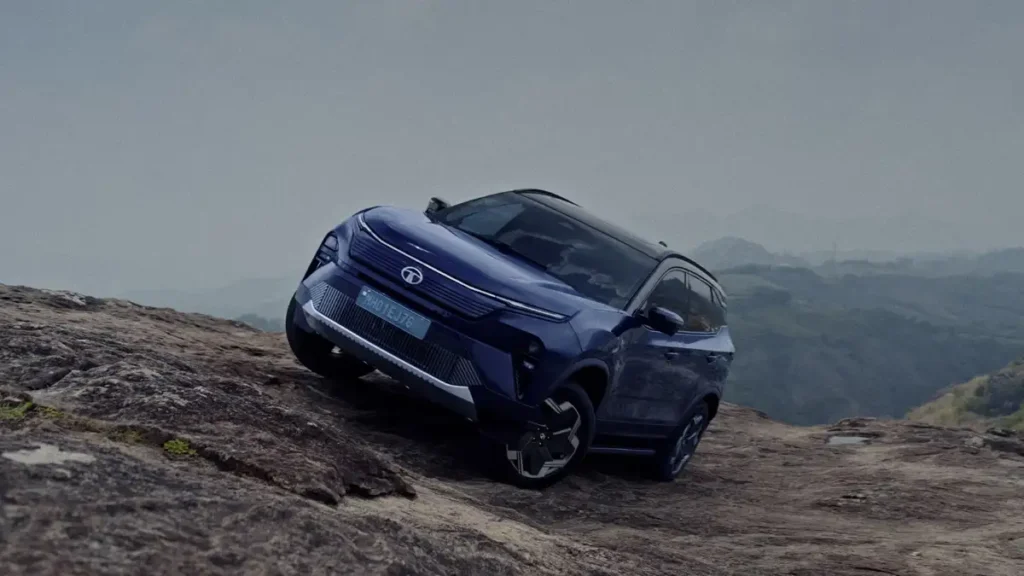
Overview
Tata Motors has taken the bold step of electrifying its best-selling SUV — and the result is impressive. The Tata Harrier EV combines strong dual-motor performance, everyday practicality, and a beautifully calibrated ride. It may look similar to the diesel Harrier, but everything under the skin has changed.
Priced between ₹21.5 lakh and ₹29 lakh, the Harrier EV brings all-wheel drive, a huge 75 kWh battery, and a 622 km claimed range — making it one of the most well-rounded electric SUVs in India today.
Powertrain and Performance
The Harrier EV uses a dual-motor setup:
- Front Motor: 158 hp (induction motor)
- Rear Motor: 238 hp (synchronous motor)
Together, they deliver a combined 313 hp, good for a 0–100 km/h time of 6.3 seconds (tested at 6.67 s). The front motor assists mainly under acceleration, while the rear does most of the driving in regular conditions.
Even with all that power, Tata has tuned the motors beautifully — there’s no jerky surge, just smooth and consistent acceleration.
Driving Modes
- Eco, City, Sport, and a Boost mode for instant overtakes.
- Calibration is spot-on — City mode keeps things calm, while Sport delivers punch without hair-trigger throttle response.
Throttle and steering both feel well-weighted, lending the Harrier EV a solid, confident personality.

Battery and Range
The 75 kWh battery is central to the Harrier EV’s capability. Tata claims:
- 622 km MIDC range, and
- 490 km “C75 real-world” range based on customer data.
During testing, real-world range hovered around 436 km, which is excellent for an SUV of this size.
Charging
- 120 kW DC Fast Charging: 20–80% in just 25 minutes.
- AC Home Charging: 7.2 kW setup standard for home installations.
Ride and Handling
The shift to electric power prompted Tata to completely rework the Harrier’s suspension. The result — ultra-glide independent rear suspension, which genuinely earns its name.
Over broken tarmac and rough roads, the ride quality is outstanding. It soaks up potholes and expansion joints effortlessly, maintaining composure even at higher speeds.
Body roll is well contained through corners, and even with its 2.2-ton weight, the Harrier EV feels stable and balanced. Only at highway speeds over long undulations does a mild float from the rear appear, but it’s minor.
Interior and Features
The Harrier EV’s cabin mirrors the updated ICE version but gains premium touches and new tech.
Highlights
- 10.2-inch digital instrument cluster
- 12.3-inch Samsung OLED touchscreen (first in India)
- 360° camera system (slightly laggy but clear)
- Digital rear-view mirror with smooth camera feed
- Dual-zone climate control
- Cooled and powered front seats
- Panoramic sunroof
- ADAS with low-speed auto braking
The quality of materials feels solid, with soft-touch surfaces and neatly integrated screens. Touch controls for some functions can be fiddly, but physical toggles for temperature help usability.
Rear Seat Comfort
Tata has made clever use of the EV platform to ensure space isn’t compromised.
Rear Comfort Details
- Seating position is natural — no “knees-up” posture.
- Flat floor for the middle passenger.
- Power boss mode allows rear passengers to move the front seat forward.
- Rear tray table and 65W Type-C chargers for both sides.
- Window blinds, wide headrests with side wings, and fold-down armrest with cupholders.
Ride comfort at the back is superb, soaking up almost every road imperfection. Only mild heaving on undulating highways is noticeable — likely due to the rear motor weight.
Design and Exterior Details
Visually, the Harrier EV sticks close to the ICE model but adds subtle EV cues.
Exterior Highlights
- Closed-off grille with textured grooves to mimic airflow
- Full-width LED DRLs with connected light bar
- New EV-specific bumpers and underbody panels
- Frunk (17 kg capacity) for storing charging cables
- All-new TIDAL platform (Tata Intelligent Digital Architecture Layer)
- 17-inch aerodynamic alloy wheels
At the rear, LED light bars stretch across the tailgate, with the rear camera integrated into the shark-fin antenna for the digital mirror feed.
Boot space stands at 502 liters (up to the roof) — only slightly less than the diesel model, and Tata has even retained a space-saver spare wheel, which is rare in EVs.
Driving Experience and Refinement
Refinement is a standout feature. The motors are nearly silent, and road noise is impressively contained. The cabin stays peaceful even on rough asphalt, while the electric drivetrain delivers effortless torque without any vibration.
ADAS calibration is smooth — especially low-speed auto braking and lane assist. Steering feels slightly heavy at parking speeds but perfectly weighted at highway pace.
Verdict
The Tata Harrier EV successfully blends performance, practicality, and comfort into one convincing electric SUV. It’s fast enough for enthusiasts, refined enough for families, and tough enough for Indian roads.
Pros ✅
- Strong dual-motor performance (313 hp)
- Superb ride quality over broken roads
- Real-world range above 400 km
- Comfortable, well-equipped cabin
- AWD capability — unique in its segment
Cons ❌
- Slight rear float over long undulations
- Steering could be lighter in tight spaces
- 360° camera feed slightly laggy
Final Word:
The 2025 Tata Harrier EV is Tata’s best product yet — powerful, efficient, and incredibly well-balanced. It doesn’t chase gimmicks; it focuses on doing everything right. This is the new benchmark for Indian-built electric SUVs.
Pravin is a tech enthusiast and Salesforce developer with deep expertise in AI, mobile gadgets, coding, and automotive technology. At CarzCorner, he shares practical insights and research-driven content on the latest tech and innovations shaping our world.
